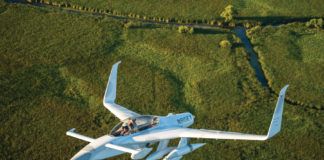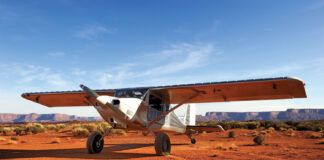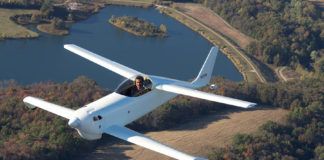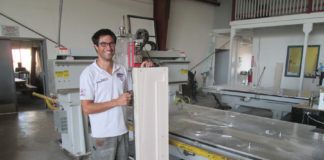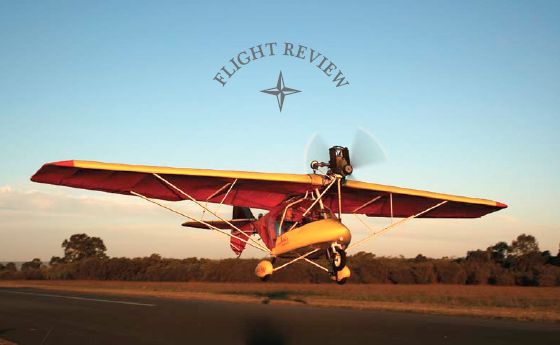
This is just what flying should be about: drifting low over the treetops and scattering the roosting crows on downwind, then diving in a gentle curve onto base leg, floating down final approach at a slow but extremely safe 45 knots, and sideslipping past the photographer on the runway’s edge to demonstrate this neat and inexpensive little airplane to its best advantage.
The vehicle making this possible? It’s called the X-Air (sometimes X’Air), and it is one of the cheapest ways to get airborne. In these financially difficult times, buying an X-Air might be a sensible alternative to selling the house if you want to continue flying. Keep it in a shed on a farm field (it certainly does not have to be a big one, nor possess uncluttered approaches) or share hangar space to further drive costs down. There are many ways to keep flying while the stock market panics.
A Hop from the Weed
The X-Air is an Indian-built French design, originally developed in 1993 from American John Chotia’s 1970s immensely popular Weedhopper. The production company, Raj Hamsa Ultralights, also sells five models of hang gliders and powered hang gliders. The baseline X-Air 502T has a 50-horsepower Rotax 503 engine. The featured model X-Air 602T uses a 58-hp Rotax 582. Next comes the X-Air 604T, with a 60-hp HKS 700E, while the top-of-the-line X-Air 702T uses a 70-hp AMW 540L70 engine. Other than engine size, the airframes are identical.
A more recent development is the more conventional looking Hanuman or X-Air Hawk, which uses either the same Rotax 582 as in the featured aircraft, or a four-cylinder, four-stroke Jabiru 2200 powerplant.
In the U.S., X-Air USA imports three models intended to use the Rotax 582 or the Jabiru 2200: the X-Air Standard, the X-Air F (for flaps) and the more conventional X-Air H (Hawk). The X-Air kit has a claimed 100-hour average assembly time (ranging from 80 to 120 hours), simply by following the instructions on a DVD supplied with the kit. The kit contains many pre-assembled parts to speed up the building process.
However long it takes to build, the design boasts a roomy, 55-inch-wide cockpit with comfortable seats, dual controls, differential toe (drum) brakes, elevator trim, proper suspension (the maingear uses the rear springs and bounce-damping shock absorbers from Indian-built Royal Enfield motorcycles), 13.2-gallon (3+ hour) fuel tank, and the resulting airframe is said to be stressed to +6/-3 G. Cruise speed is a sightseeing rather than blistering 65 knots, with a claimed 23-knot stall. Supposedly, more than 1300 X-Airs have now been sold.
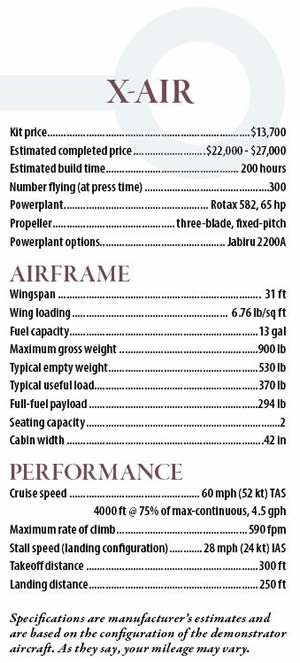
Providing Structure
The X-Air’s primary structure is aluminum tubing held together with steel bolts, and critical joints are bushed or sleeved. The Dacron fabric covering is held in place by hook-and-loop tape, making it much easier to remove and replace or repair than it would be on a more conventional airframe. Wing surfaces are virtually double skinned, with wide-span ailerons outboard, but no flaps (except in the F model). All of the tail surfaces are similar, and all controls are cable operated. With an empty weight of about 550 pounds, the 1179-pound maximum weight allows a realistic payload of full fuel plus two 250-pound adults.
Getting into the X-Air is the only tricky part; after that, everything is instinctive. The (optional) upward opening doors are flexible Lexan, framed with lightweight aluminum tubing, and opened by twisting them gently off their location pegs. Short stays prop them open; rubber handles keep them closed. The awkwardness of entry is because a pair of struts and a wheel in its wheelpant obscure the bottom center of each doorway. I achieved access from both ahead of the struts and behind them, but neither was gainly.
So Let’s Go
Once ensconced, there is plenty of length and width for two, with comfortable floor-level seats and comprehensive harnesses, good all-round vision and enough instruments for this sort of flying. Startup requires full choke (on an overhead structural tube), and the Rotax bursts instantly to life. Because it was designed with less experienced pilots in mind, the X-Air’s panel is well-endowed with placards. One says: “Best idle 2800 rpm,” and it’s correct. Below that the Rotax gearbox chatters uncomfortably.
Taxiing is similarly simple, with effective differential toebrakes and good, direct nosewheel steering. The airplane can be turned in its own length, making light of even the trickiest obstacle courses. Again, there is a checklist right in front of you on the panel, but there’s little to do before takeoff once the engine’s running.
The takeoff itself is pretty darned quick, too. I barely had the throttle fully open before we were in the air, this little springbok leaping off the turf in well under 300 feet. I just had time to spot our liftoff speed at 35 knots. The panel placard says: “Takeoff 70 meters,” and I believe it, though Jane’s All The World’s Aircraft quotes 220 meters (722 feet) to clear a 50-foot obstacle.
Climbing at a conservative 55 knots to be super safe in this super light and slightly draggy airframe, I was unable to get the stopwatch in my new cell phone to cooperate, so I counted the seconds, timing the climb at 750 or more feet per minute. The low airspeed makes for a spectacularly steep climb angle.
High-Altitude Cruise…
As we continued to 3000 feet MSL, the engine temperatures stayed well within their limits (also placarded, with the stickers sensibly sited right beside the appropriate dials). At first this slightly flexible airframe seemed a mite flimsy (and I had excited a sinusoidal wave along the wings by waggling up and down on one tip during my preflight inspection). Then I realized it was my perception rather than a true lack of structural strength, for had I not also marveled at a Boeing 747 wing’s flexibility when waggling its tip up and down at Everett, Washington, a couple of decades ago?
Reaching 3000 feet in a little over 4 minutes, I left the throttle wide open to see just what speed could be achieved, and the ASI slowly crept up to 68 knots (70 knots or 80 mph true) at a rather buzzy 6300 rpm. The Vne is 80 knots/93 mph, so this gave us a comfortable margin. Reducing power to the recommended maximum cruise setting of 6000 rpm brought the speed back to 63 knots, or 65 KTAS. That is 75 mph, and precisely as advertised. Throttling back to 5000 rpm brought our speed down to 43 knots, ideal for loitering, sightseeing and circling, and yet still with a comfortable 50% margin over the power-on stall speed.
All these speeds could easily be trimmed using the lever by my right elbow, which operates a small tab on the left elevator. There is no trim in the other axes, nor is it needed. Fuel consumption should be around 4 gph, giving at least 3 hours’ safe endurance, and Raj Hamsa quotes a 165-n.m. still-air range. Fuel capacity is marked by felt pen lines on the semitransparent linked twin tanks behind the seats, as well as being indicated on the panel gauges.
Gaining Confidence, Control
The X-Air’s controls surprised me, for they exhibited none of the dainty skittishness one might expect from such a lightweight airplane. They operated more like a bigger, heavier aircraft’s, requiring quite an effort to maneuver at higher speeds. Nevertheless, the roll rate was comfortably similar to a production airplane’s, taking 2 seconds to roll from 45° of bank one way to the other at 55 knots. Despite the ailerons’ differential, a squeeze of rudder was always required to coordinate turns. All three axes required similar effort, so the harmony was fine, and stability was strongly positive in all axes. Indeed, I was able to let the X-Air fly along happily for ages while writing my notes.
Downward visibility is peerless, as is the visibility all around the horizon, particularly ahead over that tiny nose. Twirling round and round at 50 knots enabled close and continuous inspection of everything below us. My only criticism is that this airframe configuration inevitably blocks the view overhead, and thus into turns, too. When you close the throttle and lower the nose to dive at 70 knots, you almost (but not quite) lose sight of the horizon up ahead behind the leading edge. I needed a little right rudder to counteract the yaw caused by that power reduction, though at no time did I notice much need for any left rudder with high power settings, so presumably there is some built-in offset to the vertical stabilizer.
Slowing for a stall (as you would expect from the NACA 4412 airfoil), I could barely perceive a light buffet 1 to 2 knots before the break, but this might not be noticed at all if a stall was induced inadvertently. There is no artificial stall warning, but the controls become so light, the nose is raised so high, and the stalling airspeed is so incredibly low at 27 knots, that I doubt it would happen by mistake. Also, recovery was immediate upon relaxation of back pressure. Few aircraft fly so slowly, making this a particularly safe airplane. Its predecessor, the Weedhopper, claimed a mere 10-foot altitude loss during recovery from a stall.
Gliding back to the pattern at 45 knots, I was surprised by the distance we covered relative to our altitude lost. This draggy airframe is certainly no sailplane, but it went further than I had anticipated. Should a steeper descent be needed, sideslipping worked well, even right up to full rudder deflection, which appeared to double our descent angle. Quoted minimum sink rate is 588 fpm.
Initially being wary of the X-Air’s low inertia, I made my first approach at 55 knots, but soon realized that was far too fast and caused an unnecessarily long float, so I progressively reduced the speed to 50, and then to 45 knots. Even then, we still floated, but not so far that, crossing the threshold at 40 knots, I couldn’t achieve a sensibly short landing. Even at our crawling pace, there was still plenty of elevator to get a proper nose-high touchdown, though you do have to bring the control column back quite quickly because of the rapid, drag-induced speed reduction. Pushing off the drift caused by a 10-knot crosswind was never an issue either; there seemed to be plenty of rudder, probably enough for an even higher crosswind.
Cycle Gear
As mentioned, the maingear’s suspension comes from a Royal Enfield motorbike, assuring a gentle touchdown every time, with no bounces, and it is tough and strong enough to absorb the punishment of novices. Once properly on the ground, and with the nosewheel lowered, I was able to apply heavy braking and stop in well under 300 feet. Alternatively, opening the throttle caused a wallaby-like bounce back into the air at 40 knots and straight into an enthusiastic 50-knot climb.
Flying my newfound flexible friend round and round the pattern of a deserted country airfield on a summer’s evening, banking and turning, gliding and sideslipping, while the sun waned toward the horizon, bathing the lush green foliage below in golden light, I was reminded of nothing so much as sailing a dinghy on a tree-lined river.
You don’t use a dinghy to go places—at least not seriously. But you can have tremendous fun sailing back and forth, tacking and gibing, reaching and running, going nowhere in particular with one hand resting lightly on its tiller, a sheet in the other, and your eyes on the wind in its sails. Not particularly practical, but wonderfully relaxing. The X-Air is like that.
For more information, visit www.x-air.us.

